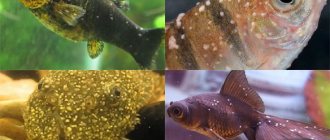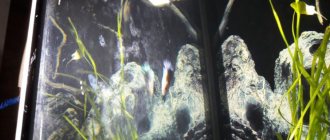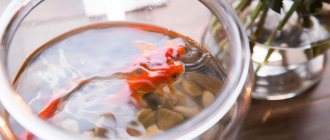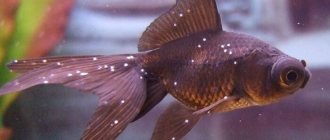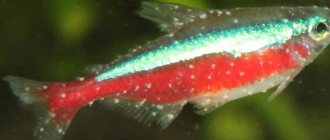Ichthyophthiriasis/semolina is a contagious disease that affects the body of fish. The disease spreads very quickly throughout the entire aquarium. Therefore, if signs of the disease are detected, measures must be taken immediately.
The carrier of Ichthyophthyriosis is the ciliates Ichthyophthirius. These are the simplest biological organisms, reaching a size of 1 mm in adulthood. The parasites, once in the container, attach themselves to the body of the fish and begin to feed on the tissues of its body. As a result, white or gray grains are formed on the scales, reminiscent of semolina. Having sucked out all the vital juices of the victim, ichthyophthirius leaves the fish’s body and burrows into the aquarium soil. The infected fish dies, and Ichthyophthyriosis bacteria actively multiply and settle on the scales and gills of other inhabitants of the reservoir. If treatment is not taken promptly, all fish will die within one week.
There is also a tropical type of Ichthyophthyriasis. A distinctive feature of this variety is the development and reproduction of parasites directly on the body of the individual.
Causes and symptoms of the disease
Currently, there are three main causes of the disease. Let's look at them in more detail:
- When feeding aquarium fish with live types of food, the risk of parasites entering the aquarium increases. Another way the disease can spread is through new plants that carry infected cells on their stems. Ichthyophthirius (a parasitic ciliate) can also live in the body of an individual that does not outwardly show signs of infection. But under ideal conditions, the disease “wakes up.” An infected fish poses a threat to other inhabitants of the aquarium;
- In some cases, after purchasing a new fish, the previous inhabitants of the tank suddenly become ill. Interestingly, the “newbie” himself feels great. The thing is that Ichthyophthyriosis bacteria can accumulate in the mouth or gills of a fish. Interacting with other aquarium fish, the “sick” releases parasites and infects “indigenous residents” who have no immunity to the disease;
- Another reason why aquarium inhabitants become sick with semolina is the appearance of a carrier fish that has acquired resistance to the virus, but has not been completely cured. When such a fish mates with other individuals, the semolina will spread in the aquarium. In a particularly unfavorable case, when two individuals infected with bacteria mate, new varieties of the virus arise that are resistant to the influence of drugs. Therefore, when introducing new fish, aquarists are advised to place them in a separate container, essentially quarantine them, and monitor their condition.
It is important to identify symptoms in the early stages of the disease and take the necessary measures. The main signs of atypical behavior of fish during the infection period include:
- deterioration of appetite or its complete absence;
- the fish becomes timid, constantly shudders, twitches its fins, itches against the surface (plants, soil, etc.);
- New growths appear on the scales (in the early stages they can only be seen from a certain angle);
- often the fish sits motionless at the very surface of the water.
Fish infected with nematodes
There are over 6000 species of nematodes. All of them can infect fish. If such a nuisance happens, the fish becomes inactive, but at the same time eats a lot. Over time, the abdomen swells and the spine becomes crooked. A sick fish dies.
A pet infected with nematodes infects healthy fish throughout the illness. This happens through waste products and from the touch of a sick individual to a healthy one. If you can’t get rid of the worms, go to the store and purchase a nematode control product.
How to treat semolina/Ichthyophthiriasis
Semolina can be treated with traditional methods and medications. When using pharmaceutical drugs, it is important to strictly follow the instructions for use of the drug. Also check the dosage and under no circumstances exceed the indicated values. As for unconventional methods of treatment, they were known at the dawn of the development of aquarium fish breeding. Let's look at the main ones:
Hydrogen peroxide
This treatment method uses a 3% hydrogen peroxide solution. The course of treatment is carried out until complete recovery. The essence of the procedure is to add a solution of hydrogen peroxide to water. The proportion of the drug is calculated as follows: 1 ml of solution per 10 liters of water. Carry out the procedure at least 2 times a day.
Treatment of Ichthyophthyriosis with salt
This type of treatment consists of adding table salt to the aquarium and then heating the water to 32 degrees. Salt should be used in the following consistency: one tablespoon of the substance per 10 liters of water.
Preparation “Malachite green”
When using the drug, be careful: a large amount of the substance negatively affects the well-being of the inhabitants of the artificial reservoir! Therefore, add dye in a proportion of 0.06 mg per 1 liter of water with each water change. It is necessary to treat until the signs of Ichthyophthyriosis cease to appear.
A mixture of the medicine “Malachite green” with other
It is effective if “Malachite Green” is mixed with potent antiprotozoal drugs. It is very good if you use the drug Furazolidone. You can buy this medicine at any pharmacy chain. It is capable of destroying parasites that have settled in the dermoid tubercle of fish. Before use, the Furazolidone tablet should be dissolved in warm water and stirred well. The dosage when added to the aquarium is as follows: 3 tablets of 50 mg per 50 liters of water in the aquarium.
Anti-steam product
The composition of this medicine includes “Malachite green”, “Blue” and formaldehyde. “Anti-steam” is designed specifically for treating aquarium inhabitants. It is recommended to use it in a fish tank, as it can disrupt the biobalance in the aquarium. When all inhabitants are infected with Ichthyophthyriasis, the drug is added to the water at the rate of 1 ml per 50 liters. First you need to drain a quarter of the volume of aquarium water.
Description
Nematodes live everywhere: in the soil, water, near bodies of water. There are more than 24,000 representatives of this species in the world. The length of some individuals reaches 8 meters, but small nematodes from 0.3 to 8 mm in length are found in aquariums.
These are thin, white worms that can swim freely in the water, in the soil or on the walls of the aquarium. Their appearance cannot be predicted: they will suddenly appear in a pond with fish. You can bring them along with algae purchased at the pet store, so aquarists recommend that all plants be thoroughly washed before planting in the tank.
Nematodes are parasitic worms. They can even live in humans. Plants favored by nematodes rot at the roots and die. Some nematodes can live on large fish, making them uncomfortable and causing serious illness.
Nematodes are not hermaphrodites. They have males and females. Females are longer and thicker than males. They lay eggs to reproduce. Remarkably, flatworms reproduce faster in polluted aquatic environments.
To fully live and reproduce, nematodes need little - a humid environment. In the absence of moisture, the worms die.
Prevention of Ichthyophthyriasis in a community aquarium
It is always easier to prevent the spread of a disease than to use difficult treatment methods later. Prevention will help save time and money by following simple rules when purchasing aquarium fish.
First, never purchase a pet from a pet store that appears sick or lethargic. Moreover, do not take a fish if it has new growths on its scales in the form of white or gray grains.
Secondly, do not buy aquarium fish whose neighbors seem to be infected. Even if the individual you like seems healthy, in the future there is a possibility that it will become infected with Ichthyophthyriasis.
Thirdly, after you have purchased the fish, quarantine it in a separate container for at least a week. Since sellers often catch fish for sale in dubious waters, there is a high risk of picking up a specimen infected with semolina. Quarantine will help determine whether the “newcomer” is infected.
If the worst does happen, aerate the container regularly during the early stages of infection. Good oxygen supply will help reduce suffering and prevent critical spread of infection.
Conclusion
Ichthyophthiriasis is a contagious disease that can cause a lot of headaches for aquarists. To reduce the risk of disease and reduce possible consequences, you need to clearly remember and follow the main rule: when buying a new fish, be sure to keep it in quarantine before placing it in a community aquarium. It must stay in a separate reservoir for at least one week.
If there is any suspicion of the spread of infection in the container, it is necessary to immediately take measures for prompt treatment. By following these recommendations, you can save the life and health of the inhabitants of the aquarium.
Watch the treatment video:
Share with friends on social media. networks
10% DISCOUNT FOR BUYERS FROM REGIONS OF RUSSIA AND CIS COUNTRIES FOR AQUARIUMS, FISH, PLANTS, ETC.
How to get rid of nematodes
The main reason why nematodes appear in an aquarium tank is purchased plants that were not treated before planting in the tank. Therefore, experienced aquarists strongly recommend keeping new plants in quarantine for two weeks to prevent any unwanted guests from appearing with them in your home pond.
Parasites in an aquarium can appear due to excess food. If the fish cannot cope with the food you give them, it settles to the bottom and becomes a favorable environment for the development of parasites.
But not everything is so sad. If thin worms have appeared in your aquarium, there are simple and effective ways to get rid of them.
Nematodes in an aquarium will be an excellent food for fry and fish. They are especially loved by mollies, gourami or other labyrinth fish. Introduce representatives of these fish into the aquarium, and within two or three days the worms will completely disappear.
If a nematode appears in the aquarium due to excess food, you need to buy a more powerful filter and also thoroughly rinse the tank. To prevent worms from infesting the soil, it is recommended to thoroughly siphon the soil twice a week and reduce the portions of food by half.
One of the effective methods of control is increasing the water temperature. Parasites have a high survival rate, but a sharp change in temperature will be detrimental to them. Before doing this, do not forget to remove other living inhabitants from the aquarium, otherwise they will die along with the worms. Be extremely careful before transferring fish and plants to another tank so as not to take worms along with them. When the water temperature is elevated, you need to add table salt to the aquarium.
Another proven and effective way to combat worms is snails. The coils will happily eat all the worms in the aquarium, but then you will have to get rid of them. The coils also multiply quickly, filling the entire tank.
It is more difficult to fight parasitic nematodes that attach themselves to fish and plants. They are introduced into fish through waste, rotten plants or infected leaves. When fish are infected, you need to find a carrier of the parasites. The infected individual is transplanted into a separate tank and treated. If a fish infected with parasites is not transplanted in time, it will infect the entire aquarium. But here a difficulty arises, because it is impossible to recognize an infected fish at the initial stage. Her appetite may increase slightly, and her activity may decrease. As the parasites spread, external signs appear: the abdomen swells, and the fish completely loses activity.
To destroy parasites, you will have to resort to chemistry. Aquarium stores sell effective drugs to combat parasites. They are produced by large companies: Tetra, Medica. One package of the drug is designed for a tank with a volume of 400 liters. Along with the parasites, you can also kill other parasites: carp lice, tapeworms.
Another effective drug for fighting parasites is Sera Med Professional Nematol. It destroys all types of worms. This is a liquid solution with a dispenser. It is necessary to pour the drug into the tank according to the instructions and wait for it to take effect. You won't have to wait long: within a few hours the worms in the aquarium will die, and the internal parasites will die within the first 24 hours.
Many beginners are afraid that nematodes will crawl onto them when cleaning the aquarium or transplanting infected fish. These are unnecessary concerns. Nematodes can only enter humans by eating raw fish.
If aquarium parasites appear, there is no need to panic. Nematodes on tank glass are quite harmless. Many experienced aquarists specifically breed nematodes in their aquariums to feed their fish. If they cause you or the inhabitants of the aquarium inconvenience, try one of these methods. And you will forget about parasites forever.
Main types
There are free-living roundworms and parasitic nematodes. Let's consider their features.
Regular
The favorite habitats of free-living roundworms are freshwater bodies of water, seas and soil. In such an environment, their density can reach 1 million/cubic meters. m, nematodes take an active part in the functioning of ecosystems.
Free-living roundworms do not pose a danger to living organisms; their lifespan is no more than a few days. They are extremely dependent on the availability of water; fluctuations in moisture concentration are fatal for them. Salty soils are also not suitable for them.
Parasitic
But parasites are extremely resilient. They tolerate any influence of an aggressive environment and unfavorable external factors. A special feature of worms is that during such periods of the life cycle their reproductive function is noticeably enhanced.
In an aquarium, parasitic worms can quickly infect and soon destroy the entire population of fish and vegetation. Nematodes develop in several stages and can have two or more hosts: the larva parasitizes one living creature, the adult worm moves to another. As the parasite develops, it travels from one organ to another, leaving larvae there, thus infecting the entire body. Most of the representatives of the genus parasitize (or exist as commensals) on almost all types of living beings - from protozoa to humans. Nematodes that parasitize plants cause nematode diseases, and living creatures develop nematodes.
Nematode plant diseases affect the root system; invasive diseases pose a danger to living organisms. The most famous parasites of this type found in humans are pinworms, roundworms, and trichinella.
What it is?
White deposits in an aquarium are a fairly common phenomenon. This does not pose a great danger (unless it just spoils the appearance of the container) and is the result of incorrect actions and mistakes by the aquarist.
Upon examination, you can see that the plaque consists of white lumps of mucus and individual hairs with mucus strands (outwardly they resemble white worms). This structure indicates that the plaque is of bacterial origin: colonies of bacteria - saprophytes of white or whitish color, feeding on organic substances in the water of the reservoir.
White deposits in the aquarium on plants, driftwood, stones, glass and the ground surface are the result of the active growth of the number of bacteria that have found an abundant food resource.
